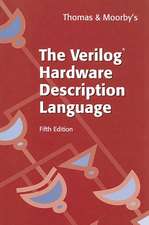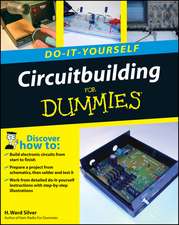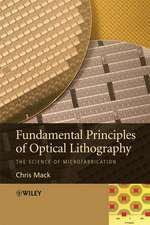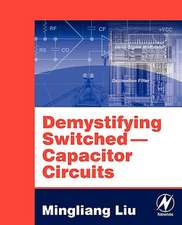Powering Autonomous Sensors: An Integral Approach with Focus on Solar and RF Energy Harvesting
Autor María Teresa Penella-López, Manuel Gasulla-Forneren Limba Engleză Paperback – 16 oct 2014
An integral approach for powering autonomous sensors by considering both primary batteries and energy harvesters is presented. Two rather different forms of energy harvesting are also dealt with: optical (or solar) and radiofrequency (RF). Optical energy provides high energy density, especially outdoors, whereas RF remote powering is possibly the most feasible option for autonomous sensors embedded into the soil or within structures. Throughout different chapters, devices such as primary and secondary batteries, supercapacitors, and energy transducers are extensively reviewed. Then, circuits and methods found in the literature used to efficiently extract and gather the energy are presented. Finally, new proposals based on the authors’ own research are analyzed and tested. Every chapter is written to be rather independent, with each incorporating the relevant literature references.
Powering Autonomous Sensors is intended for a wide audience working on or interested in the powering of autonomous sensors. Researchers and engineers can find a broad introduction to basic topics in this interesting and emerging area as well as further insights on the topics of solar and RF harvesting and of circuits and methods to maximize the power extracted from energytransducers.
| Toate formatele și edițiile | Preț | Express |
|---|---|---|
| Paperback (1) | 634.00 lei 6-8 săpt. | |
| SPRINGER NETHERLANDS – 16 oct 2014 | 634.00 lei 6-8 săpt. | |
| Hardback (1) | 639.25 lei 6-8 săpt. | |
| SPRINGER NETHERLANDS – 19 mai 2011 | 639.25 lei 6-8 săpt. |
Preț: 634.00 lei
Preț vechi: 745.88 lei
-15% Nou
Puncte Express: 951
Preț estimativ în valută:
121.33€ • 131.75$ • 101.92£
121.33€ • 131.75$ • 101.92£
Carte tipărită la comandă
Livrare economică 22 aprilie-06 mai
Preluare comenzi: 021 569.72.76
Specificații
ISBN-13: 9789400793910
ISBN-10: 940079391X
Pagini: 164
Ilustrații: XIII, 147 p.
Dimensiuni: 155 x 235 x 9 mm
Greutate: 0.24 kg
Ediția:2011
Editura: SPRINGER NETHERLANDS
Colecția Springer
Locul publicării:Dordrecht, Netherlands
ISBN-10: 940079391X
Pagini: 164
Ilustrații: XIII, 147 p.
Dimensiuni: 155 x 235 x 9 mm
Greutate: 0.24 kg
Ediția:2011
Editura: SPRINGER NETHERLANDS
Colecția Springer
Locul publicării:Dordrecht, Netherlands
Public țintă
ResearchCuprins
1. Introduction.- 2. Load and Power Conditioning.- 3. Ambient Energy Sources.- 4. Primary Batteries and Storage Elements.- 5. Optical Energy Harvesting.- 6. Radiofrequency Energy Harvesting.
Recenzii
The new book Powering Autonomous Sensors: An Integral Approach with Focus on Solar and RF Energy Harvesting provides an engaging look into the world of the Smart Powering of Wireless Systems.
The book covers the full chain of energy-processing steps for wireless autonomous sensors, i.e. sensors that are able to operate reliably with a minimum amount of power harvested from the environment. The use of various ambient energy sources available is analyzed. Methods and circuits for the efficient storage of harvested energy in batteries and capacitors are analyzed and evaluated, with detail provided for optical and RF harvesters. Circuits and systems are proposed, evaluated and tested with simulations and/or experiments performed by the authors. The main focus is the optimization of favorable circuits for low-power applications.
This work is an excellent introduction for anyone starting to work in this relatively new field of research. It is unique in its clear and consistent approach to evaluating the opportunities for and problems with energy management for low-power sensors. The many tables with features and typical component values provided by the suppliers and completed with experiment results, make it easy for readers to make a quantitative analysis by themselves.
This work is very suitable not only as an introduction for researchers, but also as study guide for graduate and post-graduate students, and postdocs.
Prof. Dr. Ir. Gerard C.M. Meijer, Delft University of Technology, The Netherlands
The book covers the full chain of energy-processing steps for wireless autonomous sensors, i.e. sensors that are able to operate reliably with a minimum amount of power harvested from the environment. The use of various ambient energy sources available is analyzed. Methods and circuits for the efficient storage of harvested energy in batteries and capacitors are analyzed and evaluated, with detail provided for optical and RF harvesters. Circuits and systems are proposed, evaluated and tested with simulations and/or experiments performed by the authors. The main focus is the optimization of favorable circuits for low-power applications.
This work is an excellent introduction for anyone starting to work in this relatively new field of research. It is unique in its clear and consistent approach to evaluating the opportunities for and problems with energy management for low-power sensors. The many tables with features and typical component values provided by the suppliers and completed with experiment results, make it easy for readers to make a quantitative analysis by themselves.
This work is very suitable not only as an introduction for researchers, but also as study guide for graduate and post-graduate students, and postdocs.
Prof. Dr. Ir. Gerard C.M. Meijer, Delft University of Technology, The Netherlands
Notă biografică
Maria T. Penella-López received her BSc, MSc and PhD degrees in Telecommunication Engineering from Universitat Politècnica de Catalunya (UPC), Spain, in 2003, 2005 and 2010, respectively. She also worked as assistant professor at UPC. In 2007 she performed a stay at the Laboratory of Electronics of the École Polytechnique Fédérale de Lausanne (EPFL), Switzerland. Her research interests include energy harvesting, energy and power conditioning for low-power autonomous sensors, storage elements and wireless sensor networks. She has co-authorized several conference and journal papers, and two patents. She is currently working on wireless sensor networks for smart cities and energy harvesting at Urbiotica S.L.
Manuel Gasulla-Forner received the Enginyer (MEng) and Doctor Enginyer (PhD) degrees in Telecommunication from the Universitat Politècnica de Catalunya (UPC), Barcelona, Catalonia, in 1992 and 1999, respectively. Since 1993 he has been with the UPC, where he is an associate professor, engaged in teaching on Analog Electronics and Electronic Instrumentation. In 2001-2002 he was a Visiting Postdoctoral Fellow at the Electronic Instrumentation Laboratory, Delft University of Technology, The Netherlands. His research interests include capacitive sensors, sensor interfaces, wireless sensor networks, and energy harvesting circuits and methods for low-power autonomous sensors.
Manuel Gasulla-Forner received the Enginyer (MEng) and Doctor Enginyer (PhD) degrees in Telecommunication from the Universitat Politècnica de Catalunya (UPC), Barcelona, Catalonia, in 1992 and 1999, respectively. Since 1993 he has been with the UPC, where he is an associate professor, engaged in teaching on Analog Electronics and Electronic Instrumentation. In 2001-2002 he was a Visiting Postdoctoral Fellow at the Electronic Instrumentation Laboratory, Delft University of Technology, The Netherlands. His research interests include capacitive sensors, sensor interfaces, wireless sensor networks, and energy harvesting circuits and methods for low-power autonomous sensors.
Textul de pe ultima copertă
Autonomous sensors transmit data and power their electronics without using cables. They can be found in e.g. wireless sensor networks (WSNs) or remote acquisition systems. Although primary batteries provide a simple design for powering autonomous sensors, they present several limitations such as limited capacity and power density, and difficulty in predicting their condition and state of charge. An alternative is to extract energy from the ambient (energy harvesting). However, the reduced dimensions of most autonomous sensors lead to a low level of available power from the energy transducer. Thus, efficient methods and circuits to manage and gather the energy are a must.
An integral approach for powering autonomous sensors by considering both primary batteries and energy harvesters is presented. Two rather different forms of energy harvesting are also dealt with: optical (or solar) and radiofrequency (RF). Optical energy provides high energy density, especially outdoors, whereas RF remote powering is possibly the most feasible option for autonomous sensors embedded into the soil or within structures. Throughout different chapters, devices such as primary and secondary batteries, supercapacitors, and energy transducers are extensively reviewed. Then, circuits and methods found in the literature used to efficiently extract and gather the energy are presented. Finally, new proposals based on the authors’ own research are analyzed and tested. Every chapter is written to be rather independent, with each incorporating the relevant literature references.
Powering Autonomous Sensors is intended for a wide audience working on or interested in the powering of autonomous sensors. Researchers and engineers can find a broad introduction to basic topics in this interesting and emerging area as well as further insights on the topics of solar and RF harvesting and of circuits and methods to maximize the power extracted from energytransducers.
An integral approach for powering autonomous sensors by considering both primary batteries and energy harvesters is presented. Two rather different forms of energy harvesting are also dealt with: optical (or solar) and radiofrequency (RF). Optical energy provides high energy density, especially outdoors, whereas RF remote powering is possibly the most feasible option for autonomous sensors embedded into the soil or within structures. Throughout different chapters, devices such as primary and secondary batteries, supercapacitors, and energy transducers are extensively reviewed. Then, circuits and methods found in the literature used to efficiently extract and gather the energy are presented. Finally, new proposals based on the authors’ own research are analyzed and tested. Every chapter is written to be rather independent, with each incorporating the relevant literature references.
Powering Autonomous Sensors is intended for a wide audience working on or interested in the powering of autonomous sensors. Researchers and engineers can find a broad introduction to basic topics in this interesting and emerging area as well as further insights on the topics of solar and RF harvesting and of circuits and methods to maximize the power extracted from energytransducers.
Caracteristici
An integral approach is provided for powering autonomous sensors encompassing batteries, storage units and energy harvesters Batteries and supercapacitors are extensively described and characterized The most important ambient energy sources are described jointly with their energy transducers Includes supplementary material: sn.pub/extras












